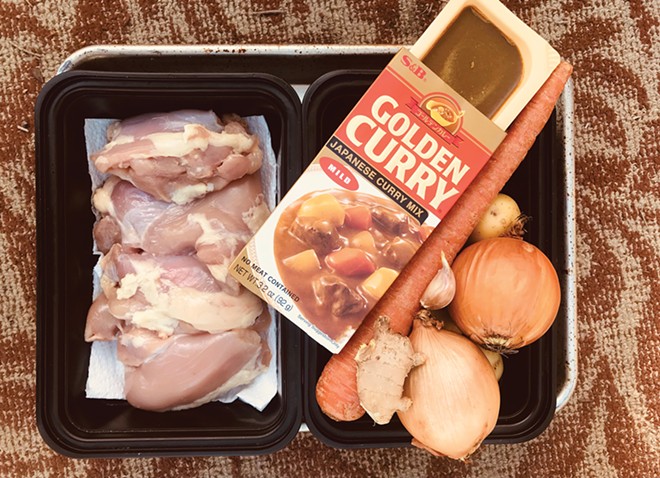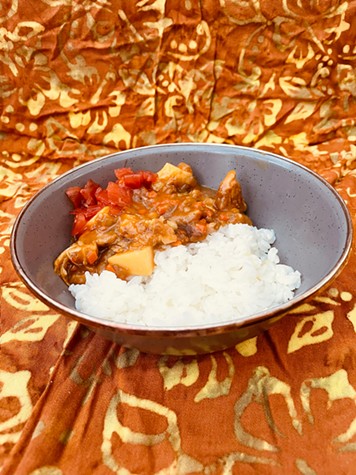In Japan, kare raisu, or curry rice, is the equivalent of our beloved mac and cheese in the blue box. Kare raisu is a rich, velvety roux-based stew and is considered to be Japan's national home-cooking dish. It's consumed two to three times a month on average in Japanese households. Kare raisu is the number one favorite food of kids. It's the standard Friday meal served to the Japanese navy.
Kare raisu belongs to a class of dishes called yshoku, Western foods introduced during the Meiji Restoration (1868-1912). Japan had been closed to the outside world for around 250 years. Foreign entry or Japanese departure was punishable by death. Buddhist and Shinto beliefs prohibited the consumption of meat.
A popular story of its introduction goes like this: A starving Japanese boy hid himself aboard a British ship. Curry was served once a week by the British navy, and this was the day the boy happened to stow away. He enjoyed the meal so much that when he returned home, he told his village about this wonderful dish, and the news quickly spread throughout the land. More likely what happened is as follows: In 1868, Emperor Meiji opened Japan to foreigners and in 1872 lifted the ban on eating meat, which changed the Japanese diet forever. The Meiji era coincided with the height of British colonial rule. At some point in the 18th century, the British began to incorporate an Indian-inspired spice blend that they called "curry powder" into their cooking. In 1772 Crosse & Blackwell released the UK's first curry powder. Courtesy of the British navy, curry was introduced to Japan around 1870 in the form of a Western-style roux-based stew mixed with Crosse & Blackwell curry powder. The Japanese adapted this dish to create their own version: kare raisu.
Kare raisu was originally served only in Western-style restaurants in Japanese cities. But in 1923 a major earthquake devastated Tokyo and kare raisu stalls popped up all over the city offering an inexpensive, hearty meal. In 1930, the Japanese company S&B started selling "Hidori Brand Curry Powder," making kare raisu accessible to home cooks. In 1966, the company released Golden Curry, a curry-spiced, shelf-stable roux in a block form that resembled a chocolate bar. Making kare raisu at home became a quick and simple task, ready to go in about half an hour. Requiring only minimal chopping, meat and vegetables are simmered for about 20 minutes. Then the curry block is added and it quickly melts, both flavoring and thickening the stew. Now store-bought curry roux blocks are so ubiquitous that it's considered the only "authentic" way to prepare Japanese curry.
Today there are five brands of curry roux blocks sold in the United States. Golden Curry and Vermont Curry are the most well-known brands sold in Asian markets and can often be found in the international section of well-stocked grocery stores. They are available in mild, medium and hot versions. One package makes five portions. Kare raisu is always served with short-grained rice and is usually garnished with a bright red pickled relish known as fukujinzuke. Fukujinzuke can be found in Asian markets or purchased online from Amazon and Walmart.
Japanese curry rice with chicken
Serves 4 or 5
Ingredients:
1 lb. boneless, skinless chicken thighs, cut into bite-sized pieces
Sea salt and freshly ground black pepper
1 medium carrot
2 medium onions
1 lb Yukon gold potatoes
1 teaspoon grated ginger
1 clove garlic, minced
1/4 apple – peeled, cored and grated
1 tablespoon neutral oil (such as canola, rice bran or grapeseed)
2-1/2 cups chicken broth (homemade or low-sodium store-bought) or dashi or water.
1 package Japanese curry roux cubes
For serving:
Cooked Japanese short-grain rice
Fukujinzuke (Japanese pickled vegetables)
Preparation
Season the chicken pieces with salt and pepper.
In a Dutch oven, heat oil over medium-high heat until it shimmers. Add the chicken pieces in two batches and cook until lightly browned on both sides, about 6 minutes. Transfer chicken to a plate and set aside.
Lower the heat to medium low, add the onion and sauté until lightly browned, about 10 minutes.
Add the garlic and ginger and sauté a few minutes more.
Add chicken stock or dashi and bring to a boil, and reduce heat to maintain a simmer. Add the grated apple to the stock.
Return the chicken back to the pot and add potatoes and carrot. Adjust heat to medium-low and simmer, covered, for 15 minutes, stirring occasionally. Cook until a wooden skewer goes through the carrots and potatoes.
Turn off the heat. Put the roux cubes into a ladleful of hot cooking liquid, one cube at a time, slowly letting them dissolve, and stir into the broth to thoroughly incorporate.
Simmer, uncovered, on medium-low heat, and stir until the curry becomes thick, about 5-10 minutes.Taste and season with salt as needed. If the curry is too thick, you can add water to thin the sauce. If it's too thin, cook for longer.
Once you reach your desired consistency, spoon into a bowl over a generous mound of warm short-grain rice. Garnish with fukujinzuke pickles if desired.
Peter Glatz travels and lives in a converted school bus with his wife and dog, exploring regional foodways.



